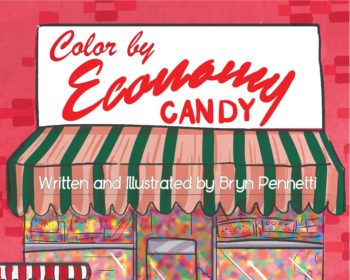Ungentrified Sweets in a Gentrified City
The Poetry of Everyday Life, blogpost 13
By Molly Garfinkel and Steve Zeitlin

In the 1976 film Taxi Driver, Travis Bickle, played by Robert De Niro, buys some Chuckles from the concessions stand at the adult cinema. He tells the concessions girl that he prefers Jujubes because they last longer. If he were in a movie theater today, he certainly would not find Jujubes and probably not Chuckles, either. He would be given a choice of mostly Haribo candies and varieties of its juggernaut gummy bears. These are today’s gentrified candies. Although the German gummy bear has been around since 1922, the Haribo company recently swallowed up a slew of other confections manufacturers all over the world, and churns out over a hundred million bears in different varieties every day.
If De Niro were looking for Jujubes now, his best bet would be Economy Candy, at 108 Rivington Street, on the Lower East Side, which opened its doors in 1937, and which thankfully is NOT endangered.
Where else can you find not only Jujubes but Dots, licorice pipes, Gobstoppers, Cinnamon Bears, Charleston Chews, a five-pound Hershey bar, or a Betty Boop Pez dispenser? This is a place to go for what we call ungentrified candy. It’s a place that offers a plethora of flavors and shapes that you can’t find anywhere else, at least not all together in one extravagant “Big Rock Candy Mountain.” Economy Candy sells the sweets many of us above a certain age delighted in as children. It’s a place that resonates with our memories of taste, a place that can still surprise us. This variety of tastes and experiences, this historic resonance, is what the city should—and sometimes does—offer, but not without our vigilance and advocacy.

Let’s imagine that New York City was made of candy. The city’s glass towers and big-box stores would be the Haribo gummy bears: crystalized corporate candy. Places like Economy Candy, Katz’s Delicatessen, Yonah Schimmel’s Knishery, and the Eldridge Street Synagogue might be the venerable but still extant Jujubes, licorice pipes, Chuckles, and Spearmint Leaves – or the spice drops in your grandmother’s crystal candy jar that like older buildings smack of yesterday. But many candies are now extinct: Chicklets, black licorice dollars, Mary Janes and now –say it ain’t so! – Necco Wafers. They remind us of the city’s bygone places – Mars Bars (the Lower East Side dive bar not the candy bar), 5 Pointz (the famous Queens mural space), CBGB, the Domino Sugar factory, the Lenox Lounge, the house under the roller coaster in Coney Island, Music Row and now even the Cornelia Street Café.
It’s not that we care so much about candy, but we do care about a diversity of tastes, of experiences in the city. We care about the experiential difference between buying a piece of penny candy from friendly soul at a neighborhood bodega and trying to even find a human being to ask where an item is located in a big-box store.
The iconic Economy Candy is a metaphor for these tastes and experiences. The shop has been in the Lower East Side for over sixty years. Before the Great Depression, the storefront housed a hat and shoe store, with a vendor selling candy from a pushcart outside its doors. During the Depression, the candy started selling better than the shoes and hats. When Morris “Moishe” Cohen and his brother-in-law returned from World War II, they took over the business. Moishe’s son Jerry and Jerry’s wife, Irene, inherited the shop in the 1980s, and, like Moishe, took pride in kibitzing with the customers. Currently, Jerry works part time and their son and his wife run the store.
Today, the Lower East Side emporium, which we were pleased to honor in 2011 with a Place Matters Award, is a thriving pilgrimage site. Neon marshmallow Peeps seem to glow from the counters, hollow chocolate bunnies patiently perch on beds of plastic grass, and bins stacked nearly to the ceiling contain every jellybean flavor on record. In parts of the store, mirrors reflect the merchandise below, so shoppers can feel gleefully surrounded by candy.

At City Lore, we have been inspired by the San Francisco Legacy Business Registry, which, as its website states, “works to save longstanding, community-serving businesses that so often serve as valuable cultural assets,” and which uses a nomination process similar to that used for historic landmarks. We urge New York City to follow suit, but with some key differences.
First, the San Francisco registry, which is itself endangered, relies on the government giving grants to landlords to keep legacy businesses affordable. Grants to landlords? Even the registry has come to realize this is not sustainable. Second, commercial rent control is simply anathema to recent New York City mayors and most city council members. When we brought up cultural landmarking at a city council meeting years ago, we were laughed out of the room for suggesting something so economically infeasible. Thankfully, the Small Business Jobs Survival Act, which was first introduced in 1986, is currently being reconsidered. We strongly support it.
City Lore’s also proposes a Community Anchors rent-subsidy program for cultural landmarks. Small businesses would be nominated for the program with petitions based on their contributions to neighborhood stability and quality of life. If it’s possible to do this for historic landmarks, as the city already does, we believe it’s possible to do this for cultural landmarks. But the number of Community Anchors would be limited so as not to have a significant effect on the overall city economy: this program would not be commercial rent control to upend the city’s economic viability. We would limit the number of Community Anchors whose rent increases would be limited to perhaps less than 2 percent of any landlord’s properties, with a negligible effect on their profits. City politicians are hesitant to consider or strategize about this, claiming that the state constitution forbids it; yet commercial rent control did exist in the city between 1945 and 1963 under a special law. Yes it will take a bit of creativity on all sides, because last we heard the people make the laws and their purpose is not to serve as a straightjacket for the common sense reforms this rapidly gentrifying city sorely needs.
New York is in a constant state of change. If it weren’t, Economy Candy would still be a shoe and hat shop. Thankfully there are still ungentrified newsstands where you can buy a pack of Chuckles. But let’s find a way to protect Community Anchors. For if we don’t, as the folklorist Alan Lomax once put it, “Soon there where be nowhere to visit and no place to truly call home.” As for the gentrified candies, we’ll just swallow hard.








3 thoughts on “Corporate Candy”
Bravo! How can we have Heritage Tomatoes and not Heritage retailers? I still mourn when Economy stopped selling Joyva Halvah and Jelly Rings in the purple boxes with the clear plastic window.
NYC landlords have always claimed that any pro-tenant regulations will drive them to the poorhouse and nobody will ever build in the city again. They said it in the early 20th century when tenants died from cholera and the city made them install indoor plumbing and when tenants died from tuberculosis and the city made them install shaftways. It seems that the poorhouse is always looming for landlords but the tenants are always the ones who wind up there.
Wonderfully written profile & reminder of just how truly sweet both nostalgia and authenticity are. I’m embarrassed to admit that even though I only saw the store for the first time over 3 years ago, I’ve yet to check it out. (I could claim that I’m dieting, but it’d be a lie.) Thanks for unwrapping this tasty morsel of info, a delicious alternative to gentrification.
I remember discovering this place by accident about 30 years ago. I was shopping for some obscure art supplies (can’t remember exactly what it was) and felt so happy to suddenly find the bright colors and sweet innocence of these treats. I hope this place remains in business and isn’t shoved out by the rent increases of gentrification.